A Little Prince, an Arabian Night, and an Italian Grandmother: Holiday Drama
Ann Klefstad and her eleven-year-old daughter Maja went to three plays in three days, seeing what the Cities have to offer in theater for kids (and grownups too) at holiday time. Read on for their conclusions.
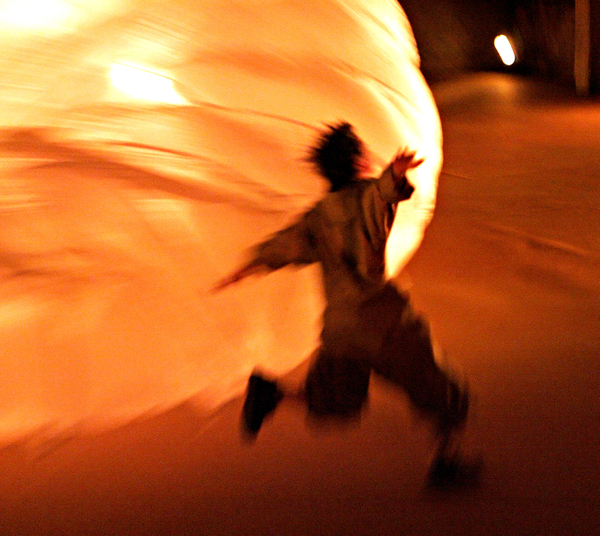
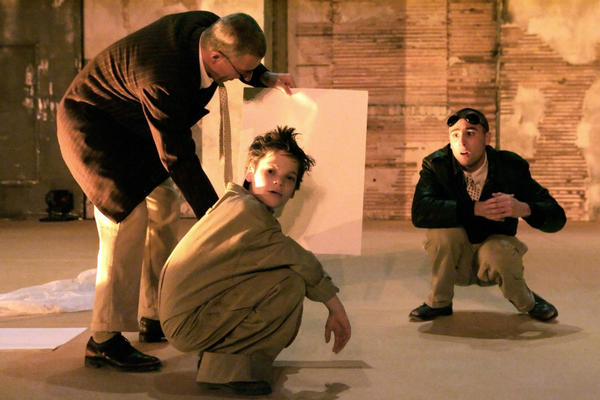
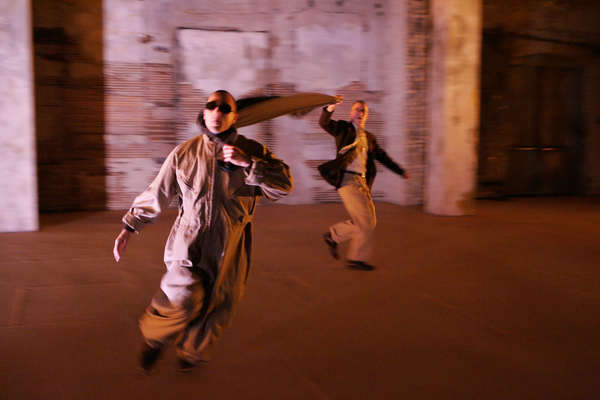
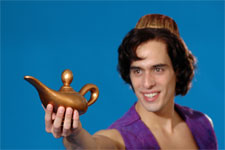
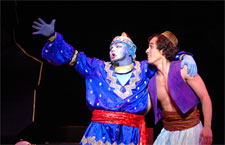
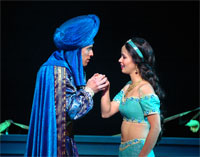
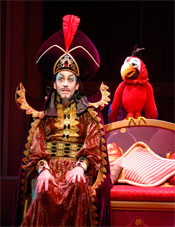
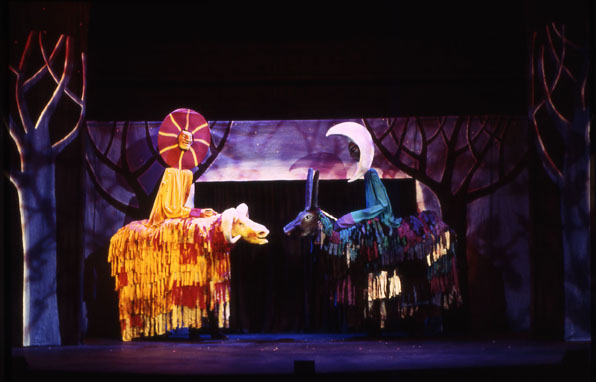
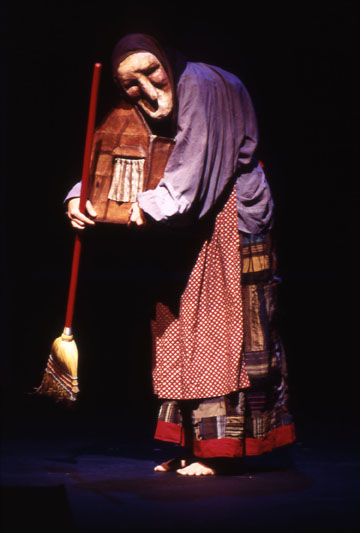
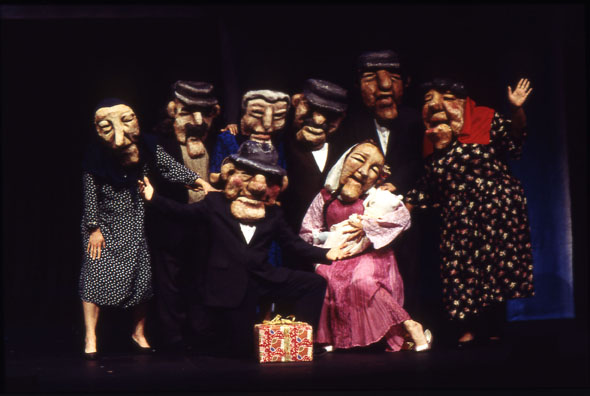
We saw “The Little Prince” at Jeune Lune (my hands-down favorite), “Aladdin” at the Children’s Theater (Maja’s hands-down favorite), and “La Befana” at the Heart of the Beast Puppet and Mask Theater, which we both loved in parts but had trouble with in the whole.
We’ll review each play separately, and interrupt each other often. Jump to the end of the review for recommendations by age.
The Little Prince at Theatre de Jeune Lune, from the book by Antoine de Saint-Exupery
This was an elegant transformation of a familiar text into action, embodied marvelously by the three actors, Steven Epp and Nathan Keepers playing the pilot at different ages, and Max Friedman as the little prince (“He’s kind of scary,” says Maja, and it’s true—he’s a very beautiful child and plays his role with great directness). Dominique Serrand collaborated with Epp and Keepers on developing the play—and it’s evident that much of it comes out of the very skin of these extraordinary performers. .
“The Little Prince” isn’t really a children’s play per se (“I was the only kid there!” says Maja). She’d liked the play—she was rapt during much of it and laughed at all the right spots–so I asked her if her friends would have liked it too: “Mostly no,” she said. “Kids wouldn’t really understand the way of art in this kind of play. Maybe my friend Cassidy would like it, but she likes more kind of fairy stuff, and not really the kind of fantasy this was.”
I was interested in the way the very real story of the pilot’s flight and crash—the author’s flight and crash–kept getting tangled up with and then departing from the fable of the little prince, until he becomes the realest thing in a direly real situation. But Maja noted, “They didn’t emphasize the crash —When they did, like when he said “Ouch” and held his head, it was funny, not serious.”
What was Maja’s favorite part of the play?
“That was when the Little Prince was visiting the other planets. They did it in very funny ways, and the word choices were good.
“Like, the lamplighter, his planet could only fit two men and the lamp and it spun really fast so the days were short. They circled the lamp, turning it on and off, saying ‘good morning’ and ‘good evening’, every couple of seconds, and between they would have a conversation. And at the end of the scene the lamplighter said, ‘A month has gone by while we’ve been talking.’
“And the man who was ‘exact,’ who was counting the stars, he said ‘I count the little things, up there—‘ ‘You mean the flies?’ ‘O no not the flies, the bright things’ ‘The bees?’ ‘No, no the golden things up there—‘ ‘The stars!’ ‘Yes, those. I count them.’ ‘But what do you do with them?’ ‘I count them, and then I count them again’ ‘But why?’ ‘Because nobody else does!’”
There are almost always a couple of levels here, one of wit and play, and one of a darker self-deprecating and lacerating humor that becomes very intimate by the end. But that kind of emotional subtext is generally not to an eleven-year-old’s liking. Kids tend to be empiricists, unassailable by the kinds of sentiment that adults indulge in. Maja’s reaction to the prince’s wounded love for his rose can stand as evidence: “The flower thing didn’t work for me. A flower, it has thorns, it hurts you, that’s the way it is.”
But she liked when the pilot showed his childhood “drawrings number 1 and number 2,” including the altered pronunciation of the word ‘drawing’, as if it was bending under the importance it had to bear. And she appreciated the device of having the pilot played by two men: “It was good, splitting the character into two, because then you have the older person telling the story and the younger person acting it out. It works.” I asked if she thought that the little prince was also the same person—after all, he was wearing pilot’s coveralls. She said, “In a way, but the main character was more interested, when he was a kid, in boa constrictors than in sheep. A boa constrictor can eat sheep. And the main character is interested in survival, and in repairing his plane and getting out of there. The little prince is interested in flowers and sheep. But in a way, they’re like the same person at different ages.”
It’s usually a sign of danger when adults in a play begin to disparage “grownups” and align themselves with children. One anticipates death by sentimental drowning. But this danger is averted–odd bits of business like the bending of the pronunciation of “drawing” into “drawring” magically nudge you away from the oversimplification of childhood.
This is aided by the qualities of the text itself. Exupery took two stories –a very real and concrete one about a plane crash in the desert, rife with vividly lived sensory detail and very adult desperation, and one fantasy, woven with both acid wit and broken-hearted tenderness, and then he forces them together in ways that insist on their parity. It’s not quite possible to maintain stickiness when there’s real danger of death from thirst.
Also, the bareness of the stage, a honeycolored flat expanse with a hole in it, militates against the usual cozy-hearted sentimentality. Every element is as austere as possible. This is a play of voices—each voice distinct, but all in some sense the voice of a single man, which is made plain at moments that cleave through the narration like knives. One violin (played without insistence by Alison Pincus) provides most of the other sound.
Epp and Keepers perform simple but absolutely precise and telling physical enactments of flying, using a scarf, early in the show. The crucial arrival of the prince is comic: he’s suddenly draped over the pilot’s back, out of nowhere. These kinds of inventive formality evoke, as so often with this troupe, earlier theaters, the commedia del’arte, the pantomime, genres between dance and drama, where the body must speak, and where its expressivity becomes magic. It’s the country where a scarf is a scarf, and the wing of a plane, and the horizon, and the surface of the sea—and it’s not an illusion that fools the eye. It fools, instead, the mind, the heart. There’s something completely unsentimental about this. The grubby world, thin in its means, is laid down before one and one is made to love it. It’s just suddenly obvious that there’s no choice. You have what you have to use, and it has to be enough.
Theater that departs from loud attempts at coercive emotion has got to be better for kids than the usual high-decibel indulgences. I was surprised to see no children at this performance. Though, as my daughter says, “Kids would only like this if they understood this way of art.” But they can only come to understand it through experience.
“Aladdin” at the Children’s Theater
This is the Disney “Aladdin,” Broadway style. It was Maja’s favorite (“This was the best one of all! I liked the music and the dancing and the acting and everything!”) and deservedly so—the Children’s Theater’s full-on gloss, confidence, and stagecraft give kids theater that’s designed for them but with every bit as much professionalism as any show for adults. This isn’t what you’d call deep, but hey—it’s a musical, and the hoofers are spot on, the voices good, and the songs road-tested by Hollywood. It’s a lot of fun.
As in all classic picaresque, the piece opens with our guides—canny street types, missing a few teeth but knowing everything—filling us in on the real story: inept king, princess under duress, evil prime minister, the city in a mess. The music is great, there’s a real pit orchestra, and when our hero Aladdin (Jorge Maldonado) appears, the charming thief, he’s a matinee idol with a real singing voice and some chops as a dancer. In other words, this is a sleek production but not a slick one: it’s a class act.
That said, there’s a lot of overacting, but it suits the genre, so doesn’t offend. Our boffo villain, Jafar (Bradley Greenwald), is much funnier in the stage version than in the movie—he preens his self-love with burlesque effectiveness, he shimmys much better than my sister Kate, and that bulbous purple headdress he’s wont to caress—well, sometimes a cigar is just a cigar, but not this time. He shakes his little beaded belt while belting his lyrics in resonant baritone, sustaining Streisand-style closing notes for longer than seemed humanly possible.
But of course Maja’s favorite character is the Genie (Reed Sigmund), who performs the thankless task of following in Robin Williams’ footsteps with no apparent dismay and with just as much razzle-dazzle, despite not being drawn, but made of flesh and blood. His antic voices and dancing make any scene he’s in.
But the toothmarks on the scenery belong to the young lovers, Jasmine (Laurine Price) and Aladdin. The dialogue, when snappy, was great; when sappy, was a lot less so. Their love scenes were way shrill; Jasmine’s giggles made you want to marry her off – to anyone who’d take her. Also, the voice mikes made every episode of breathlessness really really loud, so you found yourself hyperventilating along with the happy pair, an uncomfortable situation. But no one really seemed to care much. Maja explains why:
“I liked the dancing and the singing in the Genie’s part; I liked Jafar’s and Genie’s dialogue because it was the funniest. I didn’t like the sentimental parts, it didn’t quite work. Jasmine and Aladdin seemed really nervous, and Jasmine’s giggle was too much.
“And of course I don’t like it when they focus on the main character in anything; I like it much better when they focus on the main guy’s friends. Like in “Lord of The Rings,” I hate it when they focus on Frodo. It’s just not very interesting, like, I’m the main character, look at me.
“I like drama when I get tense and nervous about what’s happening–I love it. I don’t like it when it’s all about how people feel. I only like serious drama when it’s about people doing things that are interesting.”
So when the lovers are emoting, the kids are just waiting for it to be over. No harm done.
In short, this lavish but pared-down version of the movie “Aladdin” does the shell just right—sets comic-book bright but not overly detailed; costumes lavish but coherent, mostly; secondary characters, like the street trio who served as the Greek chorus, the Genie, the lackeys, mostly well- and broadly drawn, sharp and funny, the melding of Arabic ululations and Broadway stride pretty amusing. The central story, or rather the emotion in the story some layers behind this one, is kind of a lost cause in this setting—and is probably not much missed by anyone in the audience. But the inner life ain’t what this is about—it’s an American tale of wish-fulfillment and action, and that it does very well.
La Befana at Heart of the Beast Puppet and Mask Theater
<
The best thing about “La Befana” is the way one’s body responds to the spectacle. The opening of the piece, with the ringing music and the huge sun-and-moon-crowned animal puppets that wheel and turn, sends shivers all through you. The size of these creatures, and their turning to peer down at you—the silvery music, voices saying “What a frost there is! I hear the ground singing”—all of this makes you feel your body in the world—and in a world where bodies matter.
And this is the Heart of the Beast Theater’s key insight, and its most political one—it’s in our bodies that we suffer and rejoice. To restore our rights to our own bodies, to the labor we perform with those bodies, to the children we produce—justice is a physical matter, more than an abstract one. HOBT plays make me nostalgic for a time when this was a commonplace, which was longer ago than I even want to think.
“La Befana” has been a staple of Heart of the Beast for some 15 years. It’s gathered, it seems, a lot of parts over all those years, and the most topical parts are the weakest ones—the insertions of bits of local and current politics as asides. The show is just too long for its framework of story, and dissolves into miscellany in the latter two-thirds.
The first third of the show is magnificent, the puppetry witty and inventive, especially in the jumps in scale. We start with the huge benign beasts, and then the human-scale Befana, who is visited by giants, the Three Kings. When the Befana decides to follow these kings in pursuit of the star and the Holy Chld, she shifts size constantly, from the human Befana with a mask, to a bunraku-style puppet operated by several puppeteers, to tiny marionettes who traipse over seasonal landscapes contained in suitcases (in one of the wittiest bits of stagecraft I’ve seen anywhere). Maja was entranced by these scenes.
But when Befana is talked at by the keeper of the shelter for hurricane victims, or chased off her resting place by placards saying “Private Land—Keep Off” or “Chem Land”, or engaged in the story of neighborhood weapons turned into musical instruments and the saddened children who wield them, the story bogs down. Each of these instances could become theater, but shoehorned in shortened form into the long two hours of the Befana play, they lose energy. Maja actually was quite interested in some of these episodes as they unfolded, but this was the show she found it hardest to talk about afterwards—it was hard to get a sense of the play as a whole. This would be wonderful at a little over an hour or so, but at two hours it’s top-heavy and loses its magic.
There are over 100 characters depicted in the show; it’s impossible to credit everyone for the wonderful work they do. Maja and I were particularly impressed with Nancy Oleson’s accompaniment of the story with voice and saxophone and flutes. She creates the whole world in sound (along with other members of the band). (That all the shows we saw had live music, we thought, was a most excellent thing. )
Conclusions? Do We Have Any?
Sure! Go to any of these plays; they’re well worth it (for ticketing information, click the links below for the theaters’ websites). All the performances run through December. If you have little ones, go to “La Befana” and be prepared to leave early; if you have older, squirmy ones, go to “Aladdin” and get into it; if you have kids older than ten and who are interested in “this way of art,” by all means take them to “The Little Prince.” If you don’t have any kids, that’s the show to do as well. Maybe you can find the one you were.